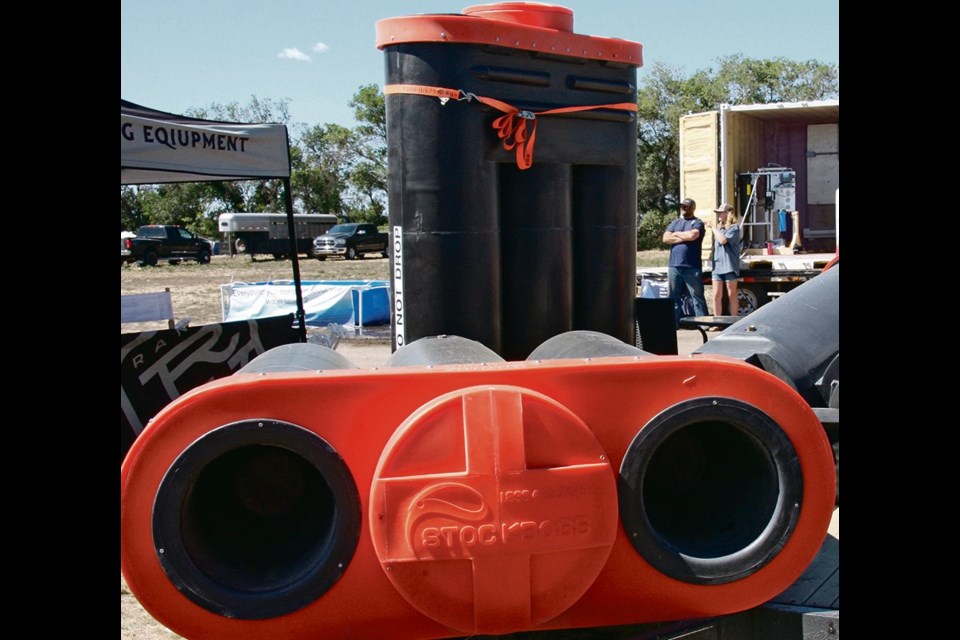SASKATOON — Ranchers who winter graze agree that getting water to the cattle in -30 C weather can just about become a full-time job. Some remedies work pretty well, others not so well.
Ice at the waterer can be chopped and removed, but a frozen subterranean water line can ruin your winter plans.
Meanwhile, there’s all that heat captured below ground. Why not put it to work?
That’s what Saskatchewan rancher David Flundra is doing with his StockBoss watering system.
Water pipes run underground from the well to his StockBoss watering troughs. The system consists of large poly drums buried 2.5 metres underground, maintaining water temperature at an even level. Well water serves the same purpose as a heat pump. In summer, it delivers fresh cool well water from deep in the Earth. In winter, it delivers water that’s been warmed by the Earth’s heat.
In actual fact, groundwater is neither warmer in winter nor cooler in summer. It just feels that way. Groundwater remains at a consistent temperature all year because the sun’s power cannot reach into Earth’s bedrock to change temperature. Well water typically comes out of the ground at about 13 C. Depending on well depth, it’s warmer from some wells, cooler from other wells.
If the outdoor ambient temperature is 32 C, the differential between 13 C and 32 C is 19 C. That’s enough to send refreshing cool water to your livestock in the summer and maybe cool your shop with the leftover temp differential.
If the outdoor ambient temperature is -30 C, that same 13 C well water carries a positive temperature differential of about 43 C. That’s enough temperature differential to prevent a winter watering system from freezing up and maybe help heat the shop.
This difference in groundwater temperature is the reason StockBoss does not require electricity, propane or other source of heat. The system only requires the normal electrical input to run the well, and that’s the limit of energy use. Flundra said the economics of land ownership pushed him to develop a new watering system.
“We needed more land for the cattle, but land prices kept going up. So, we decided we had to make better use of the land we already had. And that meant water,” Flundra said in an interview at the Ag in Motion farm show near Saskatoon in July.
“We don’t need a power hookup so we put the waterers anyplace we want them. They’re out in the middle of a pasture, or at a corner where four pastures meet. Anywhere you can run a water line. We have some on our own place that are (eight kilometres) from the pumping station.
“We start at 70 p.s.i. at the pump and still get 45 p.s.i. out at the watering station. There’s more than enough volume to handle 250 cows. That’s through rolling hills, running up and down. I started with a two-inch hose at the pump, then went down to an inch and a half.”
Flundra says cost of energy played a big part in his plan. The cost of heating a winter waterer flushed that idea down the tube. Cost of electrically heating one water trough was $3 per day. Running eight kilometres of electric wire was out of the question. And solar didn’t provide the heating power he needed for winter. He does say that both solar and wind could be used to power a well if trenching in the water line is too onerous.
He wanted a maintenance-free system that brought clean, fresh water to the cattle. He says fresh water is critical to daily weight gain and herd health.
He cites studies from Alberta and British Columbia showing that calves with cows with access to clean drinking water gained nine percent more weight than calves with cows drinking directly from ponds and dugouts. Yearlings gained 23 percent more weight when drinking clean water versus yearlings drinking from ponds and dugouts.
“We do some pretty intensive grazing. Small paddocks. And we keep changing things. You really have to be concerned with what’s happening with your soil. We’ve been mining our soils for too long. We have to start thinking in terms of improving our soils. Grazing cattle might be one of the most soil-friendly things we can do. A grazing cow returns to the pasture 77 percent of the nitrogen, 66 percent of the phosphorus and 92 percent of the potassium she eats.”
The single barrel StockBoss sells for $2,100 while the larger double barrel unit sells for $2,500.
He says StockBoss has been in production six years, and has sold thousands of the units across the Prairies and into northern U.S. states.




